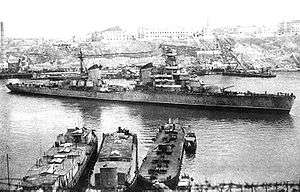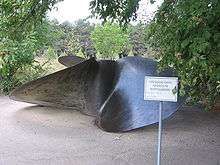Soviet cruiser Voroshilov
 Voroshilov | |
| History | |
|---|---|
| Name: | Voroshilov |
| Namesake: | Kliment Voroshilov |
| Builder: | Marti South, Nikolayev |
| Yard number: | 297 |
| Laid down: | 15 October 1935 |
| Launched: | 28 June 1937 |
| Commissioned: | 20 June 1940 |
| Out of service: | 6 October 1972 |
| Renamed: | 31 December 1961 as OS-24 |
| Reclassified: | 31 December 1961 as an experimental ship |
| Refit: | April 1954 – 31 December 1961 |
| Honors and awards: | Order of the Red Banner, 8 July 1945 |
| Fate: | sold for scrap 2 March 1973 |
| General characteristics (Project 26) | |
| Class and type: | Kirov-class cruiser |
| Displacement: |
|
| Length: | 191.3 m (627 ft 7 in) |
| Beam: | 17.66 m (57 ft 11 in) |
| Draught: | 6.15 m (20 ft 2 in) (full load) |
| Installed power: | 122,500 shp (91,300 kW) |
| Propulsion: |
|
| Speed: | 36.72 knots (68.01 km/h; 42.26 mph) (on trials) |
| Endurance: | 2,140 nmi (3,960 km; 2,460 mi) at 18 knots (33 km/h; 21 mph) |
| Complement: | 872 |
| Sensors and processing systems: | Arktur hydrophone |
| Armament: |
|
| Armor: |
|
| Aircraft carried: | 2 × KOR-1 seaplanes |
| Aviation facilities: | 1 Heinkel K-12 catapult |
Voroshilov (Russian: Ворошилов) was a Project 26 Kirov-class cruiser of the Soviet Navy that served during World War II and into the Cold War. She bombarded German troops during the Siege of Odessa before being badly damaged in November 1941 by German bombers. Upon her return from repairs in March 1942 she supported Soviet troops during the Siege of Sevastopol, the Kerch-Feodosiya Operation and the amphibious landings at Novorossiysk at the end of January 1943. Her active participation in the war ended in October 1943 when three destroyers were lost to air attack and Joseph Stalin forbid missions using large ships without his permission. Postwar she was converted to a missile test ship before being sold for scrap in 1973.
Description
Voroshilov was 191.3 meters (627 ft 7 in) long, had a beam of 17.66 meters (57 ft 11 in) and had a draft of 6.15 meters (20 ft 2 in). She displaced 7,890 metric tons (7,765 long tons) at standard load and 9,436 metric tons (9,287 long tons) at full load.[1] Her two steam turbines proved to be more powerful than anticipated, producing a total of 122,500 shaft horsepower (91,300 kW). This was almost enough to achieve the ship's designed speed of 37 knots during her sea trials, reaching 36.72 knots (68.01 km/h; 42.26 mph) despite being over 650 metric tons (640 long tons) overweight.[2]
Voroshilov carried nine 180-millimeter (7.1 in) 57-caliber B-1-P guns in three electrically powered MK-3-180 triple turrets.[2] Her secondary armament consisted of six single 100-millimeter (3.9 in) 56-caliber B-34 anti-aircraft guns fitted on each side of the rear funnel. The ship's light AA guns consisted of six semi-automatic 45-millimeter (1.8 in) 21-K AA guns and four DK 12.7-millimeter (0.50 in) machine guns.[3] Six 533-millimeter (21.0 in) 39-Yu torpedo tubes were fitted in two triple mountings.[4]
Wartime modifications
When war broke out in 1941, Voroshilov was not equipped with any radars, but she received a number of British Lend-Lease radars by 1944. One Type 284 and two Type 285 radars were used for main battery fire control. One Type 291 was used for air search, while anti-aircraft fire control was provided by two Type 282 radars.[4][5]
Service
Voroshilov was laid down at the Marti South shipyard in Nikolayev on 15 October 1935; the second of the Project 26, to use their industrial designation, Kirov-class cruisers. She was launched on 28 June 1937, but she had to wait for her Soviet-built machinery to be delivered before she was completed on 20 June 1940. On 23 June 1941 Voroshilov covered Soviet destroyers bombarding Constanta, after the Germans attacked the Soviet Union, and was slightly damaged by a mine exploded by the destroyer Soobrazitelny's paravanes. She bombarded Axis troops near Odessa on 19 September with 148 180 mm shells and was transferred to Novorossiysk shortly afterwards.[6] On 2 November the ship was bombed in harbor by Junkers Ju 88 bombers of Kampfgeschwader 51. She was hit twice; one hit started a fire in #3 magazine that was extinguished by water flooding in from the second hit.[7] Voroshilov had to be towed to Poti for repairs, which lasted until February 1942. She shelled Axis positions near Feodosiya on 19 March and 3 April 1942, but was damaged by fragments from bombs from Ju 88s on 10 April and had to return to Batumi for minor repairs.[8]
On 8 and 11 May she provided fire support for Soviet troops around Kerch and the Taman Peninsula. On 27 May one of her turbines broke down, while helping to transfer the 9th Naval Infantry Brigade from Batumi to Sevastopol, and required repairs lasting until 24 July 1942. On 29 November 1942 she was damaged by nearby mine explosions while bombarding Feodonisi with 46 180 mm and 57 100 mm shells, but managed to return to Poti under her own power. Just after her repairs were completed she assisted Soviet forces landing behind German lines at Malaya Zemlya with 240 180 mm shells at the end of January 1943. On 17 February the ship transferred from Poti to Batumi.[7]
Voroshilov was withdrawn from active operations, however, after the loss of three destroyers that were attempting to interdict the German evacuation of the Taman Bridgehead to air attack on 6 October 1943. This loss caused Stalin to forbid the deployment of large naval units without his express permission which was not granted during the rest of the war.[9] The ship was transferred to Novorossiysk on 18 August 1944 and to Sevastopol on 5 November.[7] She was awarded the Order of the Red Banner on 8 July 1945.[10]
Postwar

Voroshilov was inspected in 1946 and found unsatisfactory, but she was given routine servicing.[7] She began her postwar modernization in April 1954, but the Navy reevaluated the scope of the work in 1955 and deemed it insufficient to create a fully modern ship. Unlike her half-sister Maxim Gorky, she was selected for conversion as a testbed for missile development as Project 33 on 17 February 1956. The conversion process was prolonged, as her armament was removed and she received an entirely new superstructure and masts. She consequently was not recommissioned as OS-24 until 31 December 1961. The ship was modernized under Project 33M from 11 October 1963 to 1 December 1965. Her final conversion was to a floating barracks on 6 October 1972 and she was redesignated as PKZ-19. Voroshilov was sold for scrapping on 2 March 1973.[11] Voroshilov's 14-ton propeller and 2.5-ton stop anchor are on display at the Museum of Heroic Defense and Liberation of Sevastopol on Sapun Mountain in Sevastopol.[12]
Notes
- ↑ Yakubov and Worth, p. 84
- 1 2 Yakubov and Worth, p. 90
- ↑ Yakubov and Worth, pp. 86–7
- 1 2 Yakubov and Worth, p. 88
- ↑ "British Naval Radar Equipment of World War II". navweaps.com. Retrieved 9 August 2009.
- ↑ Rohwer, pp. 82–3, 101
- 1 2 3 4 Yakubov and Worth, p. 92
- ↑ "Cruiser Voroshilov" (in Russian). Black Sea Fleet. Retrieved 9 August 2009.
- ↑ Whitley, p. 211
- ↑ "Type Kirov" (in Russian). sovnavy-ww2.by.ru. Archived from the original on 29 October 2002. Retrieved 8 August 2009.
- ↑ Yakubov and Worth, pp. 91–2
- ↑ Museum of Heroic Defense and Liberation of Sevastopol (2006). Sapun Mountain Guide (in Russian). Simferopol: PoliPRESS Publisher. p. 140.
References
- Chesneau, Roger, ed. (1980). Conway's All the World's Fighting Ships 1922–1946. London: Conway Maritime Press. ISBN 0-85177-146-7.
- Rohwer, Jürgen (2005). Chronology of the War at Sea 1939–1945: The Naval History of World War Two (Third Revised ed.). Annapolis, MD: Naval Institute Press. ISBN 1-59114-119-2.
- Whitley, M. J. (1995). Cruisers of World War Two: An International Encyclopedia. London: Cassell. ISBN 1-86019-874-0.
- Yakubov, Vladimir; Worth, Richard (2009). "The Soviet Light Cruisers of the Kirov Class". In Jordan, John. Warship 2009. London: Conway. pp. 82–95. ISBN 978-1-84486-089-0.
External links
| Wikimedia Commons has media related to Light cruiser Voroshilov. |
- (Russian) Cruiser "Voroshilov" from Black Sea Fleet (with photos)
- (Russian) Project 26 history at the Wayback Machine (archived October 29, 2002)